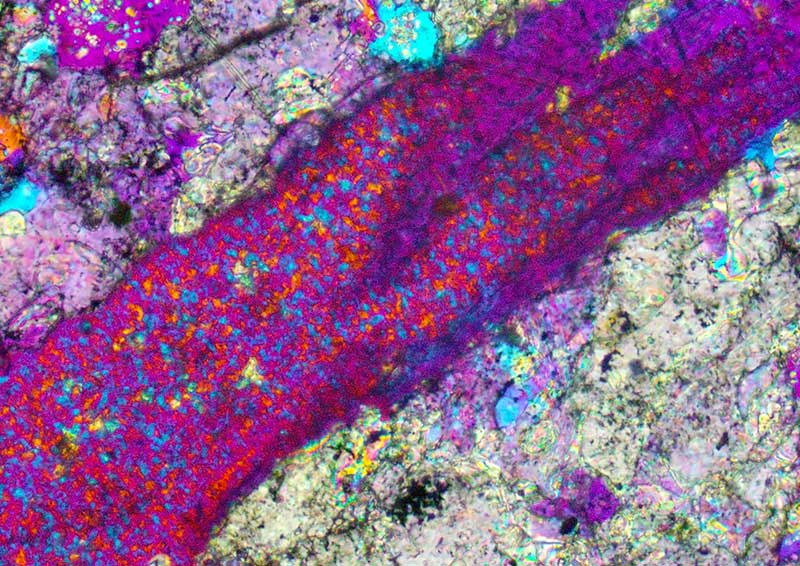Alkali-aggregate reaction (AAR)
(Microscopic view of crystalline AAR product in cracked aggregate from a concrete bridge (Leemann et al, 2016).)
[edit] Introduction
The dominance of Portland cement concrete as the world's pre-eminent structural material developed during the 19th century and continued throughout the 20th century and retains that position today.
However, the material had a 'guilty secret' that was only revealed by research in the USA during the 1930s. In some circumstances, an expansive reaction can gradually occur between aggregate constituents and alkaline hydroxides from the cement, causing damage to the hardened concrete within structures.
This has become known as 'alkali-aggregate reaction' (AAR), or most commonly and more specifically, 'alkali-silica reaction' (ASR). This AAR family of mechanisms is by no means the most frequently encountered threat to concrete durability or the serviceability of structures, but it can be a serious issue when it occurs.
It has continued to fascinate concrete research scientists and engineers ever since its first published description, some 76 years ago.
[edit] Getting to grips with AAR
Over more than 40 years, I have been privileged to witness practising engineers and applied scientists getting to grips with AAR worldwide. I believe we now understand the several reactions, including how to recognise them in existing structures and manage the situation, but crucially also including how to determine any possible AAR potential in new works and take effective precautionary measures.
However, challenges remain, especially as appreciation of the potential threat from AAR is not universally or equally appreciated everywhere in the world, and we are still finding types of structure that behave exceptionally. Overall, the prospects are encouraging for both a declining incidence of AAR damage and successful approaches to management and/or repair of affected cases.
This article was originally published by ICE on 30 June 2016. It was written by Simon Fullalove. You can see the original article here.
--The Institution of Civil Engineers
[edit] Related articles on Designing Buildings Wiki
Featured articles and news
RTPI leader to become new CIOB Chief Executive Officer
Dr Victoria Hills MRTPI, FICE to take over after Caroline Gumble’s departure.
Social and affordable housing, a long term plan for delivery
The “Delivering a Decade of Renewal for Social and Affordable Housing” strategy sets out future path.
A change to adoptive architecture
Effects of global weather warming on architectural detailing, material choice and human interaction.
The proposed publicly owned and backed subsidiary of Homes England, to facilitate new homes.
How big is the problem and what can we do to mitigate the effects?
Overheating guidance and tools for building designers
A number of cool guides to help with the heat.
The UK's Modern Industrial Strategy: A 10 year plan
Previous consultation criticism, current key elements and general support with some persisting reservations.
Building Safety Regulator reforms
New roles, new staff and a new fast track service pave the way for a single construction regulator.
Architectural Technologist CPDs and Communications
CIAT CPD… and how you can do it!
Cooling centres and cool spaces
Managing extreme heat in cities by directing the public to places for heat stress relief and water sources.
Winter gardens: A brief history and warm variations
Extending the season with glass in different forms and terms.
Restoring Great Yarmouth's Winter Gardens
Transforming one of the least sustainable constructions imaginable.
Construction Skills Mission Board launch sector drive
Newly formed government and industry collaboration set strategy for recruiting an additional 100,000 construction workers a year.
New Architects Code comes into effect in September 2025
ARB Architects Code of Conduct and Practice available with ongoing consultation regarding guidance.
Welsh Skills Body (Medr) launches ambitious plan
The new skills body brings together funding and regulation of tertiary education and research for the devolved nation.
Paul Gandy FCIOB announced as next CIOB President
Former Tilbury Douglas CEO takes helm.
UK Infrastructure: A 10 Year Strategy. In brief with reactions
With the National Infrastructure and Service Transformation Authority (NISTA).
























